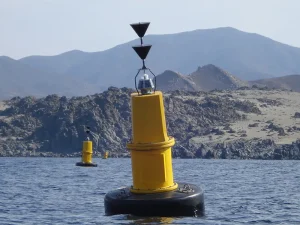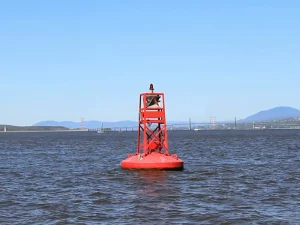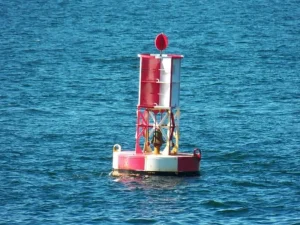Récemment, nous avons discuté de la structure des bouées marines. Dans cet article, j'ai mentionné que différents types de bouées de navigation sont utilisés dans le monde aquatique. Leur objectif premier est d'indiquer un chemin ou des canaux sûrs en mer ou sur les rivières. Cependant, leurs structures et leurs modes de fonctionnement sont différents.
Il est intéressant de noter que chaque type de bouée marque des instructions spécifiques pour les plaisanciers. Les plaisanciers qui ne comprennent pas la signification des bouées peuvent emprunter les mauvais canaux. Les types de bouées sont en effet complexes à comprendre. Mais ne vous inquiétez pas ! Je vais vous les expliquer de la manière la plus simple possible. Au final, vous serez en mesure de comprendre les bouées, leurs marques et leurs significations.
Aperçu des bouées pour bateaux

Les bouées sont des dispositifs utilisés pour assurer la sécurité des bateaux et des navires. Elles ont pour but d'indiquer le chemin ou les chenaux sûrs pour les bateaux. Les plaisanciers considèrent ces bouées comme des signaux et font naviguer leurs bateaux en conséquence. Les bouées sont généralement en plastique et peuvent rester dans l'eau pendant une longue période.
Les plans d'eau peuvent avoir différents niveaux de profondeur, n'est-ce pas ? Certains points d'eau peuvent être plus dangereux pour les bateaux que d'autres. Si les plaisanciers s'engagent sur ces points, les risques d'accident augmentent. N'oubliez pas que les bateaux sont petits et qu'il peut être difficile de maintenir leur équilibre. Par conséquent, les bateaux peuvent être victimes d'accidents.
Dans ce cas, ces bouées indiquent des chemins sûrs. Les bateaux empruntent ces chemins et sortent de l'eau. Comment ces bouées restent-elles à un endroit précis dans l'eau ? C'est une question intéressante. Les bouées sont ancrées au fond de la mer ou du fleuve, ce qui signifie que la surface les maintient en un point. Des cordes et des chaînes sont attachées aux bouées.
Lors de vents ou de vagues, ces chaînes maintiennent les bouées stables en un point. Les bouées de navigation sont utilisées dans les rivières. En revanche, les bouées marines sont généralement utilisées pour ancrer les navires. Elles guident également les navires vers des voies sûres. Ces bouées ont différentes marques, et il est essentiel que les plaisanciers les comprennent.
Types de bouées et de balises pour la navigation de plaisance
Les bouées facilitent grandement la navigation des bateaux dans les rivières et en mer. Elles indiquent les chenaux appropriés et les voies sûres. Voyons maintenant plus en détail chacune des bouées de navigation de plaisance.
1- Bouées latérales

Les bouées latérales sont les types les plus courants utilisés dans les eaux fluviales. Les plaisanciers doivent les comprendre pour naviguer en toute sécurité sur les plans d'eau. Les bouées latérales indiquent des chenaux ou des voies sûres. Si les bateaux s'engagent dans ce chenal conformément aux instructions, il restera sûr.
Le système de bouées latérales utilise des bouées colorées pour indiquer les chenaux de sécurité. En général, deux bouées de couleur sont utilisées : la verte et la rouge.
- Bouées rouges (tribord) : Ces bouées rouges constituent une sorte de point de référence pour les plaisanciers. Lorsqu'ils rentrent au port, les plaisanciers doivent garder ces bouées rouges à leur droite. Ces bouées rouges sont également appelées tribord. Si un bateau se déplace en gardant ces bouées à droite, il reste dans le chenal de sécurité.
- Bouées vertes (ports) : Ils sont également appelés ports. En voyage, les plaisanciers doivent les garder à leur gauche lorsqu'ils reviennent à terre ou au port. Le point de référence ici est le retour à terre ou le déplacement à la verticale. Si le plaisancier se déplace en gardant la bouée verte (port) sur la gauche, il risque davantage d'être confronté à un accident. Pourquoi ? Parce que ce chenal est sûr.
Ces bouées rouges et vertes (tribord et sabord) sont utilisées dans les zones dangereuses. Il peut y avoir des rochers ou des bancs de sable sur le plan d'eau. De plus, les bouées de tribord sont généralement de forme conique. À l'inverse, les sabords sont cylindriques. N'oubliez pas que les tribords et les sabords indiquent la direction à suivre lorsque vous retournez au port.
2- Bouées cardinales
Les bouées cardinales sont basées sur les directions. Elles aident les bateaux à naviguer en leur indiquant la direction exacte dans laquelle ils peuvent naviguer en toute sécurité. Il existe quatre types de bouées cardinales, chacune représentant une direction spécifique. Il est intéressant de noter que les couleurs de ces bouées sont différentes les unes des autres. Vous devez vous souvenir de leur couleur et comprendre ce qu'elles signifient.
| Bouée cardinale | Motif de couleur |
| Bouée North Cardinal | Noir sur le dessus, jaune sur le dessous |
| Bouée Cardinal Est | Noir avec une bande jaune au milieu |
| Bouée South Cardinal | Jaune en haut, noir en bas |
| Bouée West Cardinal | Jaune avec une bande noire au milieu |
Examinons la signification de chaque bouée. Comme je l'ai dit précédemment, les bouées aident à naviguer en toute sécurité en indiquant les bonnes directions.
- Bouées du cardinal de l'Est : Ces bouées signifient que les eaux situées à l'est de ces bouées sont sûres. Il est préférable de rester à l'est de ces bouées.
- Bouées North Cardinal : Ces bouées indiquent que les plans d'eau situés au nord sont sûrs pour les bateaux. Ne traversez pas les bouées, restez du côté nord. L'eau peut être dangereuse dans la direction sud de la bouée.
- Bouées de South Cardinal : Elles indiquent que le côté sud de ces bouées est sûr pour les bateaux. Ces bouées auront un ton jaune et un fond noir.
- Bouées West Cardinal : Ces bouées indiquent que l'eau est sûre à partir du côté ouest de ces bouées. Elles sont généralement ornées de bandes jaunes et noires.
Il est essentiel de se souvenir de la signification et de la couleur de ces bouées. Une petite confusion peut mettre les plaisanciers en difficulté. Rappelez-vous que vous verrez un acheteur d'une couleur spécifique au milieu de la mer. Vous devrez identifier sa signification en voyant les couleurs. Une fois que vous aurez compris ces bouées, vos bateaux resteront en sécurité.
3- Bouées de danger isolées
Les bouées isolées constituent une sorte d'avertissement, mais les bateaux peuvent les contourner. En général, elles sont installées dans des endroits peu sûrs. Les plans d'eau peuvent comporter des rochers inattendus, des épaves ou même des bancs de sable. Ces éléments rendent l'eau dangereuse pour les bateaux. C'est pourquoi ces bouées sont installées à ces endroits.
N'oubliez pas que les plaisanciers doivent être prudents, mais qu'ils peuvent tout de même circuler autour de ces bouées. Pourquoi ? Parce que ces bouées sont placées exactement dans la zone dangereuse et qu'il est donc plus sûr de les contourner. Toutefois, comme cette zone est proche d'une zone dangereuse, il convient d'être prudent.
Parlons de la structure de ces bouées. Leur couleur de base est le noir et elles sont généralement ornées d'une ligne ou de bandes rouges. En outre, le sommet de ces bouées est constitué de deux boules. Vous les verrez dans des endroits isolés où le danger est élevé. Les plaisanciers doivent les considérer comme une alerte. La combinaison de leurs couleurs est très favorable et elles peuvent être vues de loin.
4- Bouées de sécurité

Les bouées de sécurité sont différentes des bouées mentionnées précédemment. Elles ne signalent aucune zone dangereuse dans les plans d'eau. Au lieu de cela, elles indiquent les eaux sûres. Elles peuvent être installées n'importe où dans les chenaux intermédiaires ou sur les points d'entrée. Les plaisanciers ou les navires peuvent facilement naviguer dans les plans d'eau où ces bouées sont installées.
Supposons que cette bouée soit présente au milieu de la trajectoire du bateau. Cela signifie que le bateau peut passer d'un côté ou de l'autre de la bouée. Il n'y a pas de zone dangereuse à craindre. Elles sont rouges avec des bandes rouges verticales. De loin, on a l'impression que des bandes blanches et rouges se trouvent sur la bouée. En outre, une structure en forme de boule est présente au sommet de ces bouées. Ces bouées de sécurité sont généralement cylindriques ou en forme de pilier.
5- Bouées de bifurcation
Les bouées de bifurcation sont utilisées aux endroits où les chenaux se séparent. Cela signifie que les bateaux peuvent aller à droite ou à gauche, en quittant le chenal principal de la voie. Ces bouées indiquent la meilleure voie à suivre pour les navires. Ces bouées ont une forme cylindrique. Elles sont surmontées d'une lumière qui sert à indiquer le meilleur chemin.
Il y a deux feux, rouge et vert. Si une bouée a un feu vert au sommet, les bateaux doivent suivre le chemin du côté gauche. En revanche, si la bouée a un feu rouge, les bateaux doivent suivre le chemin du côté droit de la bouée.
Certaines bouées sont dépourvues de feux et se composent de couleurs rouge et verte. Elles ressemblent davantage à des feux de signalisation et indiquent la voie à suivre pour les bateaux et les navires. Leur objectif premier est de veiller à ce que le trafic maritime emprunte les voies les plus sûres. Rappelez-vous que les voies bifurquées ou séparées sont toutes deux sûres. Mais cette bouée indique les voies les plus sûres pour les navires.
6- Bouées d'amarrage
Les bouées d'amarrage ne sont pas destinées à la navigation. Elles n'indiquent pas de direction mais servent à ancrer les bateaux. En général, les grands navires jettent l'ancre lorsqu'ils veulent rester à un endroit donné. Mais les petits bateaux ne disposent pas d'un tel système d'ancrage. Ils utilisent donc ces bouées d'amarrage pendant leur séjour.
En général, ces bouées sont installées dans des endroits sûrs. Les vagues n'y sont pas trop violentes. Les plaisanciers peuvent donc facilement attacher leur bateau à ces bouées à l'aide de cordes ou de chaînes. Une fois attachés, les bateaux restent stables en un point. Même en cas de mauvais temps ou d'aile, ces bouées maintiennent les bateaux dans une position stable.
N'oubliez pas qu'il existe différents types de bouées d'amarrage. Cependant, elles ont toutes pour but de maintenir les bateaux stables à un endroit donné. Vous verrez probablement ces bouées sur les côtes ou dans les baies marines. N'oubliez pas que ces bouées peuvent également être installées dans les eaux profondes des océans. Ces bouées sont généralement de grande taille et peuvent empêcher les grands navires de dériver.
Compréhension des autres bouées (moins important)
J'ai mentionné certaines des bouées les plus essentielles dans la section précédente. L'objectif était d'aider les bateaux à naviguer en toute sécurité. Cependant, il existe d'autres types de bouées pour la navigation de plaisance. Voici un tableau indiquant leur nom et leur fonction principale :
| Type de bouée | Objectif |
| Bouée d'ancrage | Marque les zones d'ancrage sûres. |
| Bouée d'avertissement | Avertit des dangers à proximité. |
| Bouée de détresse | Indique des dangers tels que des rochers ou des eaux agitées. |
| Bouée de garde | Indique les zones interdites aux bateaux. |
| Bouée de plongée | Marque les zones pour les activités de plongée. |
Questions fréquemment posées
Qu'est-ce qu'une bouée de bateau ?
Les bouées nautiques sont des dispositifs ou des signaux qui indiquent un chemin sûr. Le plaisancier les suit pour naviguer en toute sécurité dans une eau dont la profondeur est incertaine et qui comporte d'autres éléments. Il existe différents types et couleurs de bouées qui diffèrent dans la manière dont elles communiquent des informations aux plaisanciers.
Quels sont les principaux types de bouées ?
Les bouées sont de plusieurs types, et chacun d'entre eux est différent des autres. Voici les 6 types de bouées les plus courants dans le monde marin :
- Bouées latérales
- Bouées d'amarrage
- Bouées cardinales
- Bouées de sécurité
- Bouées de bifurcation
- Bouées de danger isolées
Comment les bouées restent-elles en place ?
Les bouées sont généralement ancrées pour rester à un endroit ou à un point donné. Le matériau de construction de cette ancre varie entre le béton, le métal et d'autres matériaux. Il est lourd et ne permet pas à la bouée de se déplacer sous l'effet des courants d'eau.
Qui est responsable de l'entretien des bouées ?
La responsabilité des bouées varie selon les organisations et les instituts. En général, les autorités portuaires locales et les organisations privées entretiennent ces bouées. Ces organisations s'occupent de leur coloration, de leur positionnement et de leur entretien général.
Puis-je attacher mon bateau à n'importe quelle bouée ?
Il existe différents types de bouées, chacune ayant une fonction spécifique. Vous ne devez attacher votre bateau qu'avec des bouées d'amarrage. Il est interdit d'attacher un bateau à des bouées de navigation. Leur fonction est d'indiquer un chemin sûr, et non d'ancrer les bateaux.
Conclusion
Les bouées de navigation sont très utiles pour la navigation des bateaux et des navires. Tout plaisancier doit connaître ces bouées et ces marques. La compréhension de la signification de ces marques garantit la sécurité des bateaux et des navires.
Je ne recommande pas d'aller dans l'eau sans avoir une connaissance de base des bouées de navigation. Dans cet article, j'ai expliqué les différentes bouées de navigation. Certaines servent à la navigation, tandis que d'autres vous aident à déterminer l'état des plans d'eau. N'oubliez pas que chacun de ces types de bouées a sa propre façon de fonctionner pour faciliter la navigation.
